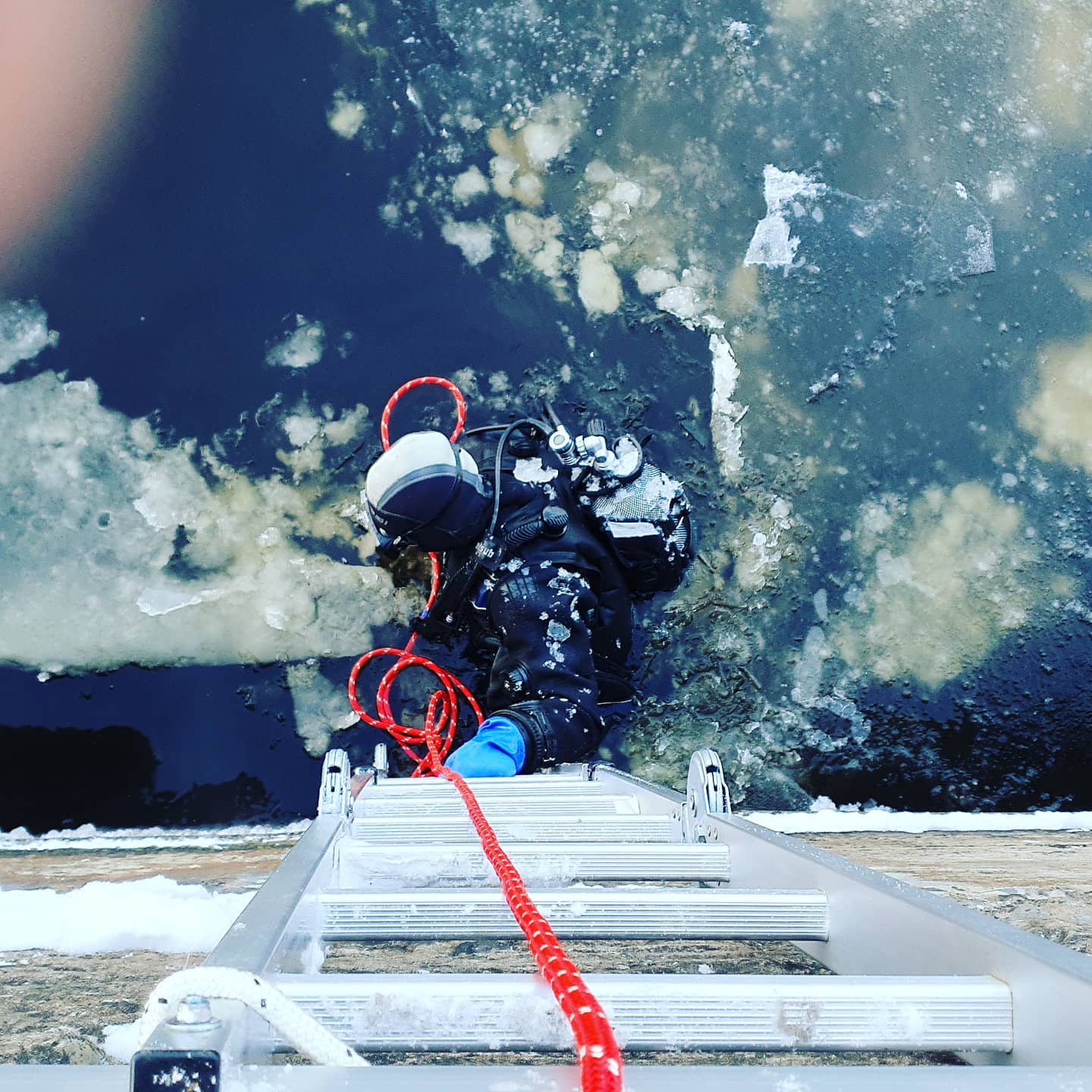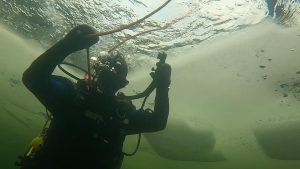Timely notification of an accident is a decisive factor in saving life! For accidents at sea, phone 115 (emergency service). The emergency telephone number of the State Fire and Rescue Service is 112.
Below is the information compiled by diving instructor and lecturer Valters Preimanis, about human survival in cold water and human survival in cold sea in winter. Properly performed regulars have been proven cold baths helps people toughen up.
Table of Contents
Read these articles if you are interested in bracing, swimming, diving and winter cold swimming:
- Cold baths for beginners
- Cold baths and tempering
- The benefits of an ice bath
- The benefits of a cold bath are why you need to do it
- Diving in autumn and winter in Latvian waters
- Motivational technique for a cold winter swim
Human survival in cold seawater
Diving instructor and lecturer Valters Preimanis says that the Baltic Sea hides not only countless forms of life, but also a giant force that not only creates, but sometimes also interrupts the flow of life. All kinds of accidents happen at sea, so you must not forget about your safety when doing any activities at sea. The purpose of this article is to explain the life-threatening dangers of prolonged exposure to the cold and to give advice on how to prevent or reduce these dangers. By learning the information in the article, you can save your life one day. It is important to know that even after falling into cold water, a person is not helpless and is able to survive. Losing body heat is a gradual process.
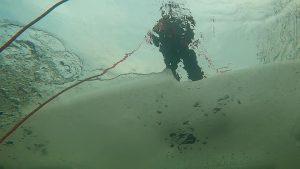
Research shows that in calm water with a temperature of +5 °C, a person in everyday clothes has more than 50% a chance to survive for three hours. Simple self-help techniques can extend this time, especially if you are wearing a life jacket. There is a lot within your power to change, and the purpose of this article is to show you how. When entering cold water, timely preparation and thoughtful action can be the most important factors in the fight for survival. This article uses materials from the Emergency Medical Service.
Human body in cold sea water
By understanding how the human body reacts to being in cold air or water, and knowing what to do to help the kermen delay the damaging effects of the cold, you will be much better able to fight for survival in such an environment. 37°C Imagine that the body consists of an inner core and an outer layer, because the body produces a lot of heat, which is generated as a result of various body functions, such as physical movement, food digestion, confirms diving instructor and lecturer Valters Preimanis.
Nature has determined that the ideal temperature inside the human body is +37 °C. The network of blood vessels that permeates the inside of the body and its outer layer carries heat throughout the body. Nature has also given the body a very precise system that automatically maintains the correct body temperature. When the ambient temperature is high, such as outdoors on a steamy day or in a hot engine room, the 2 blood vessels near the skin dilate, causing more blood to flow to the outer layer and promoting the outflow of heat from the body.
Thus, a person is able to withstand heat and the body temperature does not rise. On the other hand, in the cold, the blood vessels in the outer layer narrow, preventing the body from cooling down as quickly. Blood vessels dilate Blood vessels constrict Despite changes in ambient temperature, this regulatory system tries to keep the body's internal temperature constant. The body does this within certain limits. When these limits are approached, the body needs help to maintain an optimal internal temperature. You need to help your body with the right actions and protective clothing.
The body usually loses heat to the environment: when you are in direct contact with cold water or other substances, heat transfers from your body, which is at a relatively high temperature, to the substance, which is at a lower temperature. Different substances conduct heat differently. The thermal conductivity of water is 20 times higher than that of air; when in a stream of air or water, the cooling caused by the wind is referred to as the wind chill effect. Also, churned or flowing water around your body requires more heat output than still water at the same temperature.
Heat loss from direct contact with cold water
Loss of heat when in a stream of air or water. Almost nowhere in the world can a person survive without clothes. Clothing itself does not warm the body, it is warmed by its own heat. The body warms the layer of air trapped between the skin and clothing. This air layer also provides thermal insulation. If the air layer is lost, the insulation decreases. The air layer in the space between the skin and clothing can be disrupted by movement, water can enter it. In both cases, the valuable warm air is forced out and the skin temperature drops. In an effort to maintain skin temperature, heat from within the body is used. If heat loss to the skin is not limited, the body's internal temperature drops, concludes diving instructor and lecturer Valters Preimanis.
Hypothermia – loss of human body heat
Loss of human body heat is one of the greatest dangers to human survival in cold water. The rate at which the body loses heat depends on:
- water and air temperatures;
- wind speed;
- weather conditions at sea;
- time spent in water;
- protective clothing;
- physical and mental readiness of the victim;
- the amount of medication, alcohol or intoxicating substances in the victim's body;
- physique and behavior of that person.
Critically low core body temperature can be determined by various symptoms. In the early stages of cold exposure, the human body tries to combat excessive heat loss by constricting superficial blood vessels (to reduce heat loss through the blood to the skin) and causing shivering (to generate additional heat). If the exposure to negative conditions is too strong, the body cannot retain or generate enough heat. The internal temperature of the body begins to decrease. When the body's internal temperature falls below +35 °C, a person experiences hypothermia. The fatigue of such people, their movement coordination and orientation have been lost, numbness has set in, speech disorders have begun, it is a psychological confusion. If the core temperature continues to drop, unconsciousness may occur, muscle stiffness is replaced by shivering, and the pupils may dilate. The heartbeat becomes irregular, slow and weak, the pulse is barely felt. Death can occur at any stage of hypothermia, and when a person's body temperature is very low, it is difficult to tell whether a person is alive or dead. Death from hypothermia is defined as the inability to revive a person by rewarming them.
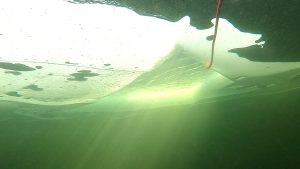
Can survive hypothermia
A person in cardiac arrest caused by severe hypothermia may survive if resuscitation measures are administered until rewarming is completed.
- Make sure of your safety and those around you.
- Check the victim's consciousness, that is, gently shake the victim by the shoulders and speak loudly to him:
- if the victim reacts/answers, i.e. is conscious: - leave the victim in the same position in which you found him or offer the victim to lie down in the desired position;
- try to establish contact with the victim, comfort, do not blame;
- protects the victim from exposure to the environment;
- If there are several rescuers, then they can take turns, taking as little time as possible for the change, and each of them performs resuscitation measures for two minutes.
- If you can't or don't want to do breathing, do only heart massage: heart massage should be done continuously, without pauses; heart massage rate 100 – 120 times per minute.
- Resuscitation measures are stopped only if: Ambulance arrives and takes over resuscitation of the victim;
- the victim begins to move, opens his eyes and begins to breathe normally;
In any accident, when the victim has lost consciousness, the principles of resuscitation should be followed.
Cold and temper increases energy, metabolism (metabolism) and weight loss
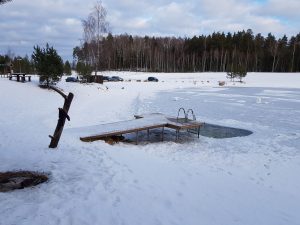
When immersed in cold water, the low temperature shock causes a feeling of energy overload (a bit of dizziness). It happens catecholamine (adrenaline and noradrenaline) and endorphins in the body in response to a cold. It's basically a huge influx of adrenaline. Researchers found that immersion in 14 C-degree cold water increases the rate of catecholamine growth by 530 percent! Ice baths upgrade metabolism and speeds up weight loss. A study of human metabolism found that exposure to cold helps white fats to act like brown fats. Brown fat is the "good fat" that helps the body to produce heat (newborns have a lot of brown fat). This means that cold bath therapy helps to burn white fat.
In conclusion about ice baths and cold therapy
Walking in cold water may require a big reception, but the benefits and feelings of an ice bath afterwards are worth it. An improved immune system, better mental clarity and health, and improved metabolism are quite tempting benefits and why it is worth pursuing.
More about tempering, ice and cold baths
Cold water shower, hardening benefits
The benefits of a cold bath are why you need to do it
Motivational technique for a cold winter swim
Where to apply for diving training in Latvia?
🤿😀 If you are looking for advice or help on the theory of cold, the sport of diving with or without balloons, call a PADI diving instructor t. 220-77-202 (Whatsapp 220-77-202) to find advice on human survival in cold water and freediving related training.

